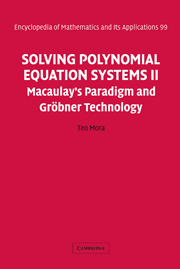Summary
If you HOPE that this second SPES volume preserves the style of the previous volume, you will not be disappointed: in fact it maintains a self-contained approach using only undergraduate mathematics in this introduction to elementary commutative ideal theory and to its computational aspects, while my horror vacui compelled me to report nearly all the relevant results in computational algebraic geometry that I know about.
When the commutative algebra community was exposed, in 1979, to Buchberger's theory and algorithm (dated 1965) of Gröbner bases, the more alert researchers, mainly Schreyer and Bayer, immediately realized that this injection of Gröbner technology was all one needed to make effective Macaulay's paradigm for reducing computational problems for ideals either to the corresponding combinatorial problem for monomials or to a more elementary linear algebraic computation.4 This realization gave to researchers a straightforward approach which led them, within more or less fifteen years, to completely effectivize commutative ideal theory.
This second volume of SPES is an eyewitness report on this successful introduction of effective methods to algebraic geometry.
Part three, Gauss, Euclid, Buchberger: Elementary Gröbner Bases, introduces at the same time Buchberger's theory of Gröbner bases, his algorithm for computing them and Macaulay's paradigm.
While I will discuss in depth both of the classical main approaches to the introduction of Gröbner bases – their relation with rewriting rules and the Knuth–Bendix Algorithm, and their connection with Macaulay's H-bases and Hironaka's standard bases as tools for lifting properities to a polynomial algebra from its graded algebra – my presentation stresses the relation of both the notion and the algorithm to elementary linear algebra and Gaussian reduction; an added bonus of this approach is the ability to link Buchberger's algorithm with the most recent alternative linear algebra approach proposed by Faugère.
- Type
- Chapter
- Information
- Solving Polynomial Equation Systems IIMacaulay's Paradigm and Gröbner Technology, pp. xi - xiiiPublisher: Cambridge University PressPrint publication year: 2005

